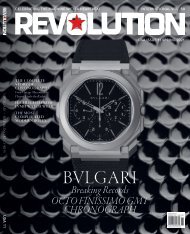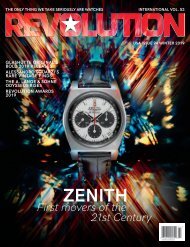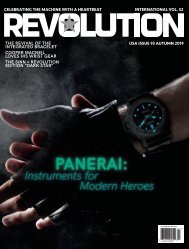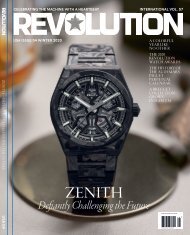Create successful ePaper yourself
Turn your PDF publications into a flip-book with our unique Google optimized e-Paper software.
CEO of Bvlgari,<br />
Jean-Christophe<br />
Babin, and Fabrizio<br />
Buonamassa (right),<br />
Director of Watch<br />
Design at Bvlgari.<br />
ORIGINS OF A HOROLOGICAL ICON<br />
But before we go into the history and milestones of the Octo Finissimo, let’s<br />
pause to examine the genesis of the integrated sports watch and the way in which<br />
Bvlgari is both spiritually aligned and yet a radical departure from its rivals. So,<br />
time was, if you were a Riviera Rake with the last name Agnelli or Rubirosa in that<br />
halcyon era between the ’50s and the ’70s, before the Côte d’Azur was overrun<br />
by oligarchs and priapically winged orange Lamborghinis that look like mobile<br />
fertility symbols, before the era of champagne bottle wars and when culture,<br />
taste and money still aligned, you had to dress in a certain way. And that was with<br />
a certain educated but nonchalant élan, a Cifonelli or Caraceni blazer worn or,<br />
better, cast over one shoulder like an old bathrobe as you hopped out of your<br />
Ferrari 250 SWB and carved your path through the trellises of connubial haut<br />
monde mademoiselles to the bar at the Hôtel du Cap. Now the watch on your<br />
wrist could hardly be something as pragmatic as a diver’s tool watch. No, what<br />
you needed to have, to casually check how many hours from sunset and that<br />
rendezvous with that Italian screen ingénue decamped incognito to a nearby villa,<br />
was an integrated bracelet, sports chic watch.<br />
In the ’70s there were two models, the Royal Oak created in 1972 and the<br />
Nautilus in 1976. The man behind both these watches, and clearly an individual<br />
with a penchant for slim timepieces with faceted bezels that exhibited a dynamic<br />
tension between bold, muscular designs counterpointed by slim (some would<br />
even say lithe) profiles, was one Gérald Genta. When Genta eventually created his<br />
own eponymous brand, he would also design an octagonal watch with an eightsided<br />
bezel. Cut to several decades later in 2000 when Bvlgari would purchase<br />
both Gérald Genta and Daniel Roth, at the time both owned by Singapore’s Tay<br />
family of The Hour Glass fame, and inherit a great deal of high-complication<br />
competences — two watch manufactures and the octagonal model that, while<br />
appealing, had not yet realized its full creative potential.<br />
Indeed, it took a few years for Bvlgari’s team of Babin,<br />
Fabrizio Buonamassa and then-watchmaking head Guido<br />
Terreni to realize what Genta’s design truly could be.<br />
However, to achieve this, they had to undertake one of the<br />
most technically innovative and daring creative programs<br />
in the history of luxury watchmaking. The complexity came<br />
about because one of the key objectives with Bvlgari’s new<br />
Octo model, to be named the Octo Finissimo, was to create<br />
the world’s thinnest mechanical watch. Says Jean-Christophe<br />
Babin, “With respect to my competitors, movement<br />
innovation like this hadn’t really been achieved since the last<br />
real pioneering era of the late ’60s, when the industry was<br />
chasing the achievement of the first automatic chronograph<br />
with Heuer, Breitling and Hamilton pursuing the Caliber<br />
11 and Zenith ultimately arriving at the groundbreaking El<br />
Primero. For us, it was never the pursuit purely to have the<br />
world’s thinnest mechanical watch. Rather, the goal was to<br />
bring that same daring, innovation and finesse that has made<br />
us a leader in the ladies’ and jewelry sector to the world of<br />
men’s watches. It dawned on us that our advantage is that<br />
we are Italian. All our watches and their components are<br />
made in Switzerland but from a design perspective, as an<br />
Italian company, we are much more open than the Swiss. We<br />
draw inspiration from Italian architecture, from fashion,<br />
from cinema, from the automotive world and from the very<br />
landscape of our home city, Rome, which is so beautiful. We<br />
decided we wanted to express the two very Italian qualities of<br />
strength and elegance in a bold and groundbreaking manner.”<br />
COVER STORY 29











